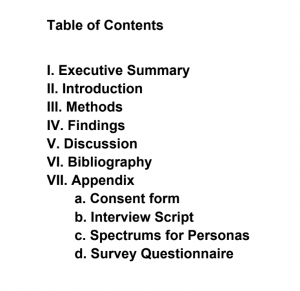Project Overview
Formative Research Formative research is a big part of the discovery process. As opposed to summative research, formative tools tend to probe for more qualitative data in attempt to provide internal stakeholders with a clearer picture of the external stakeholder’s mental model – all of which help us understand what the design plan should be. This isn’t an attempt to evaluate a fully fleshed out system, it’s an effort to discover problems, posit solutions, and in doing so, generate requirements.
In addition to common tools such as surveys and traditional interviews, perhaps the most powerful technique for gaining formative, discovery-driven insights is contextual inquiry. Contextual inquiry / ethnographic research allows us to elicit more natural, richer insights about our target user as they complete familiar tasks in their natural environment.
Here is a research report that I conducted with 3 other UX Designers that demonstrates my approach to formative techniques such as surveys, interviews, and contextual inquiry. This was a project we were recruited to complete for an organization by the name of Feeding America that was looking to gain more insight into potential areas in which a technological solution could be crafted to improve the issue of food access – both for organizations trying improve food access and for low-income communities struggling with food access.
Scope & Activities
In this report, we will discuss the lack of accessible healthy food options in low-income neighborhoods and the challenges faced by both residents of these neighborhoods and the organizations dedicated to addressing issues of food access. To better understand this problem, we conducted field observations of residents in low-income, low-access areas, held interviews with leaders of organizations focused on food access in low- income communities, and released a digital survey to examine the digital operations and data collection capabilities of these organizations. The goal of this research was to use the findings from these three methods to propose opportunities for human-centered design work and technological solutions to improve the operations of organizations working to improve these communities.
We began our investigation by completing five observations in four varied environments. Three of these observations took place in neighborhoods in Chicago designated as low- access by the USDA Food Access Research Atlas. These particular observations were conducted at a McDonald’s and an Aldi grocery store. We also observed a meeting with e.a.t. Inc., a Chicago-based nonprofit focused on the intersection of education, agriculture and technology. Our fifth observation took place at a Panera Bread in St. Augustine, Florida, which provided us with an analogous perspective on people’s food choices in a different community with better access to healthy food options.
Findings
The main factors we observed impacting people’s’ choices were 1) Price; 2) Quality; 3) Options (or lack of options) available; 4) Influence of family and friends; and 5) Access to information about healthy food options. After conducting our field observations, we decided to narrow our focus to the efforts of organizations in low-access, low-income communities, with the goal of better understanding the challenges that already-established organizations focusing on this problem were facing. We interviewed six professionals from five different organizations. Of these organizations, four were smaller in size and scope, and their efforts were primarily focused on improving their immediate local communities. In contrast, one of the organizations we interviewed was larger, with a more national, policy-orientated scope. Through these interviews, we found that organizations in this realm focus their work on addressing the following four themes: 1) Improving access to healthy food, specifically in regard to price and location; 2) Bettering education, particularly in changing negative perceptions of healthy food; 3) Advancing data collection capabilities; and 4) Strengthening relationships within the communities they aim to serve.
We further explored some of the themes from our interview findings by creating an online survey, sent to over 100 organizations focused on food access across the country. Through our survey, we learned more about nonprofits’ technological capabilities and data collection abilities, and investigated whether organizations with less ability to collect and analyze data had less indicators of program success. Some of the main findings from our survey data were that 1) Organizations are actively collecting data, although their systems for organizing or analyzing this data are not particularly robust; 2) Organizations value and maintain an online presence; and 3) Organizations do have some tech infrastructure, but generally lack staff with expert computer proficiency skills. Additionally, we discovered that nonprofits view discounts on healthy food, community support, and taste as major motivators for supporting changes in eating habits in these communities.
Our survey results were limited by a small population pool of only 28 respondents. This led to statistically insignificant findings regarding our two hypotheses. We were not able to suggest a correlation between operating budget and types of data collected by organizations. We also were not able to suggest a correlation between satisfaction with data collection and data collection abilities. We were limited by recruiting resources and time.
Based on the findings from our observations, interviews, and surveys, we found that, perhaps unsurprisingly, improving access to healthy foods in low-income areas remains the biggest challenge for residents and nonprofits alike. Changing negative perceptions through food education initiatives and building support within affected communities were also prevalent findings across all research methods. Finally, when it comes to improving the operations of nonprofits dedicated to improving healthy food access, we found that more sophisticated data collection capabilities could have a significant positive impact. In terms of potential design implications, this area is fraught with opportunity for further development, but significant additional research on nonprofits’ current operations would have to precede any such solutions. Further research opportunities on healthy food access should also involve interviewing and surveying not just nonprofits, but the “end” users, or residents of low-access areas. Future work on this subject may also benefit from narrowing the focus of this project, to obtain more directly relevant findings.
Using design to connect people, product, and business

Follow Me
Email: dash@alum.northwestern.edu
Phone: +1 312 478 7147
